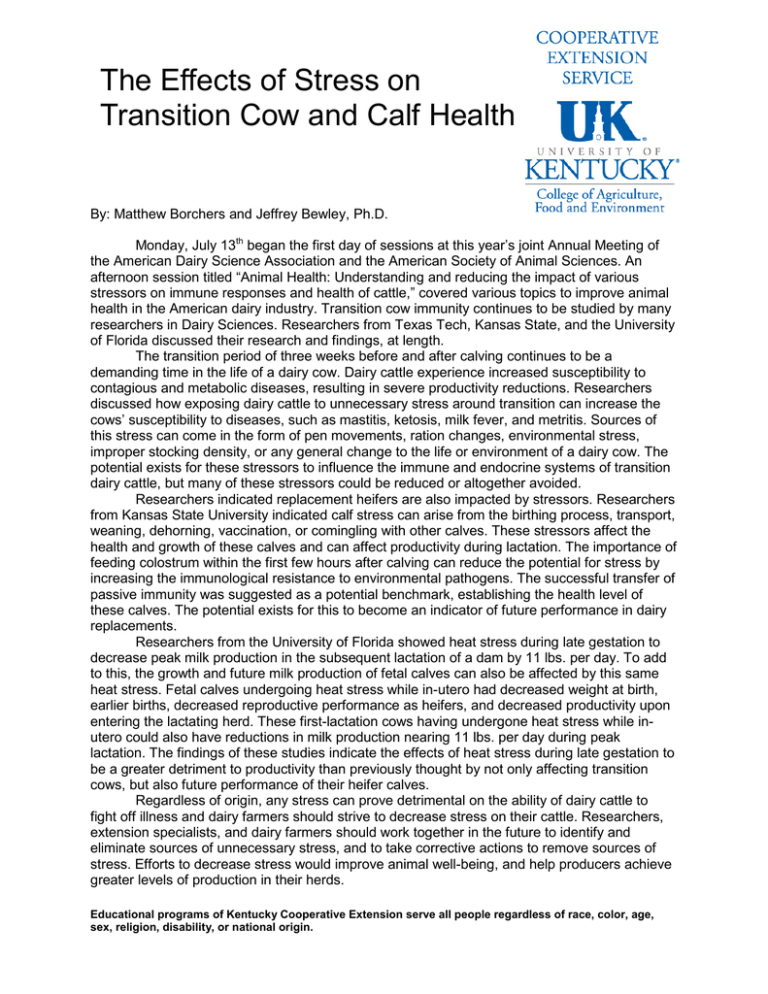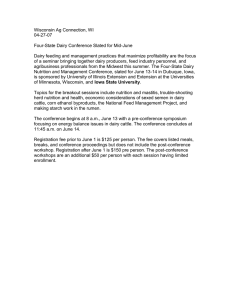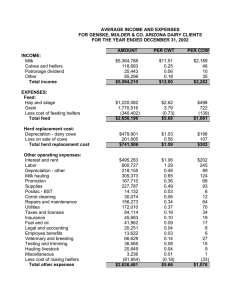The Effects of Stress on Transition Cow and Calf Health
advertisement

The Effects of Stress on Transition Cow and Calf Health By: Matthew Borchers and Jeffrey Bewley, Ph.D. Monday, July 13th began the first day of sessions at this year’s joint Annual Meeting of the American Dairy Science Association and the American Society of Animal Sciences. An afternoon session titled “Animal Health: Understanding and reducing the impact of various stressors on immune responses and health of cattle,” covered various topics to improve animal health in the American dairy industry. Transition cow immunity continues to be studied by many researchers in Dairy Sciences. Researchers from Texas Tech, Kansas State, and the University of Florida discussed their research and findings, at length. The transition period of three weeks before and after calving continues to be a demanding time in the life of a dairy cow. Dairy cattle experience increased susceptibility to contagious and metabolic diseases, resulting in severe productivity reductions. Researchers discussed how exposing dairy cattle to unnecessary stress around transition can increase the cows’ susceptibility to diseases, such as mastitis, ketosis, milk fever, and metritis. Sources of this stress can come in the form of pen movements, ration changes, environmental stress, improper stocking density, or any general change to the life or environment of a dairy cow. The potential exists for these stressors to influence the immune and endocrine systems of transition dairy cattle, but many of these stressors could be reduced or altogether avoided. Researchers indicated replacement heifers are also impacted by stressors. Researchers from Kansas State University indicated calf stress can arise from the birthing process, transport, weaning, dehorning, vaccination, or comingling with other calves. These stressors affect the health and growth of these calves and can affect productivity during lactation. The importance of feeding colostrum within the first few hours after calving can reduce the potential for stress by increasing the immunological resistance to environmental pathogens. The successful transfer of passive immunity was suggested as a potential benchmark, establishing the health level of these calves. The potential exists for this to become an indicator of future performance in dairy replacements. Researchers from the University of Florida showed heat stress during late gestation to decrease peak milk production in the subsequent lactation of a dam by 11 lbs. per day. To add to this, the growth and future milk production of fetal calves can also be affected by this same heat stress. Fetal calves undergoing heat stress while in-utero had decreased weight at birth, earlier births, decreased reproductive performance as heifers, and decreased productivity upon entering the lactating herd. These first-lactation cows having undergone heat stress while inutero could also have reductions in milk production nearing 11 lbs. per day during peak lactation. The findings of these studies indicate the effects of heat stress during late gestation to be a greater detriment to productivity than previously thought by not only affecting transition cows, but also future performance of their heifer calves. Regardless of origin, any stress can prove detrimental on the ability of dairy cattle to fight off illness and dairy farmers should strive to decrease stress on their cattle. Researchers, extension specialists, and dairy farmers should work together in the future to identify and eliminate sources of unnecessary stress, and to take corrective actions to remove sources of stress. Efforts to decrease stress would improve animal well-being, and help producers achieve greater levels of production in their herds. Educational programs of Kentucky Cooperative Extension serve all people regardless of race, color, age, sex, religion, disability, or national origin.





